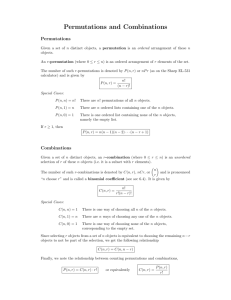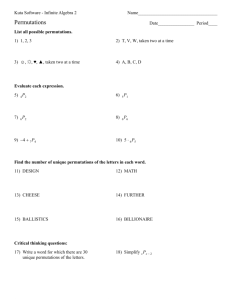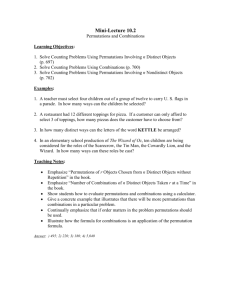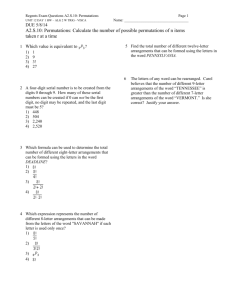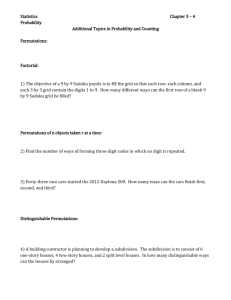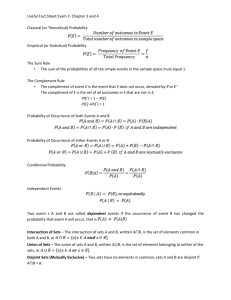Permutations
advertisement
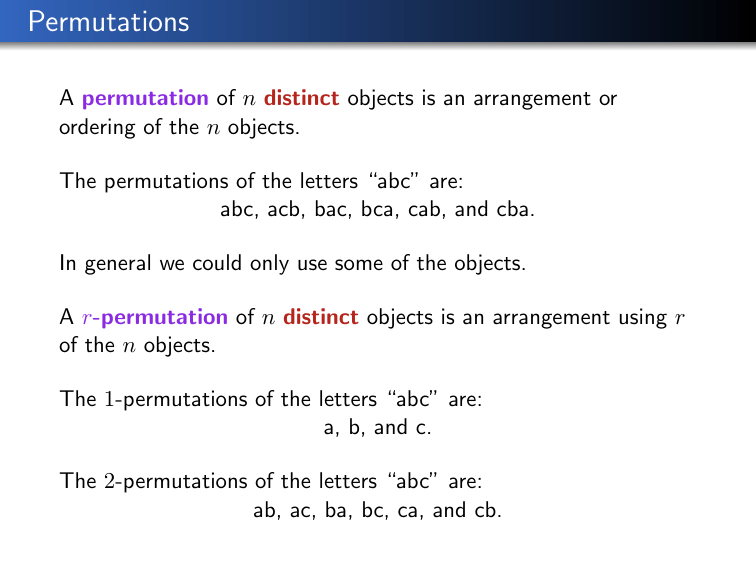
Permutations A permutation of n distinct objects is an arrangement or ordering of the n objects. The permutations of the letters “abc” are: abc, acb, bac, bca, cab, and cba. In general we could only use some of the objects. A r-permutation of n distinct objects is an arrangement using r of the n objects. The 1-permutations of the letters “abc” are: a, b, and c. The 2-permutations of the letters “abc” are: ab, ac, ba, bc, ca, and cb. Number of Permutations How many permutations are there of the letters “abcde”? Action Action Action Action Action Total 1: 2: 3: 4: 5: Pick Pick Pick Pick Pick a a a a a letter letter letter letter letter Number of Permutations How many permutations are there of the letters “abcde”? Action Action Action Action Action Total 1: 2: 3: 4: 5: Pick Pick Pick Pick Pick a a a a a letter letter letter letter letter 5 4 3 2 1 ways ways ways ways ways Number of Permutations How many permutations are there of the letters “abcde”? Action Action Action Action Action Total 1: 2: 3: 4: 5: Pick Pick Pick Pick Pick a a a a a letter letter letter letter letter 5 ways 4 ways 3 ways 2 ways 1 ways 5 ∗ 4 ∗ 3 ∗ 2 ∗ 1 = 120 ways Factorial We will see products of the form 5 ∗ 4 ∗ 3 ∗ 2 ∗ 1 frequently. The product of consecutive integers from 1 to some n is called a factorial and is denoted n!. n! = n ∗ (n − 1) ∗ (n − 2) ∗ · · · ∗ 2 ∗ 1 5! = 5 ∗ 4 ∗ 3 ∗ 2 ∗ 1 = 120 0! = 1 There are n! permutations of a set of size n. Number of r-Permutations How many 3-permutations are there of the letters “abcde”? Action 1: Action 2: Action 3: Total Pick a letter Pick a letter Pick a letter Note that this is like a factorial but we stop before reaching 1. Number of r-Permutations How many 3-permutations are there of the letters “abcde”? Action 1: Action 2: Action 3: Total Pick a letter Pick a letter Pick a letter 5 ways 4 ways 3 ways Note that this is like a factorial but we stop before reaching 1. Number of r-Permutations How many 3-permutations are there of the letters “abcde”? Action 1: Action 2: Action 3: Total Pick a letter Pick a letter Pick a letter 5 ways 4 ways 3 ways 5 ∗ 4 ∗ 3 = 60 ways Note that this is like a factorial but we stop before reaching 1. Number of r-Permutations How many r-permutations are there of a set of size n? Action 1: Action 2: Action 3: Pick the first item Pick the second item Pick the third item .. . Action r: Total Pick the rth item Number of r-Permutations How many r-permutations are there of a set of size n? Action 1: Action 2: Action 3: Pick the first item Pick the second item Pick the third item .. . n ways n − 1 ways n − 2 ways Action r: Total Pick the rth item n − r + 1 ways Number of r-Permutations How many r-permutations are there of a set of size n? Action 1: Action 2: Action 3: Pick the first item Pick the second item Pick the third item .. . n ways n − 1 ways n − 2 ways Action r: Total Pick the rth item n − r + 1 ways n ∗ (n − 1) ∗ · · · ∗ (n − r + 1) Number of r-Permutations The number of r-permutations is denoted by P (n, r). P (n, r) = n ∗ (n − 1) ∗ (n − 2) ∗ · · · ∗ (n − r + 1) = n! (n−r)! P (3, 1) = 3 P (3, 2) = 6 P (3, 3) = 6 P (n, 1) = n P (n, n − 1) = P (n, n) = n! Number of Distinguishable Permutations How many permutations of the letters “aabc” are there? Note that we can not distinguish the 2 a’s from one another. Suppose we could distinguish the a’s then the total number of permutations would be P (4, 4) = 4! = 24. aabc, aacb, abac, abca, acab, acba, aabc, aacb, abac, abca, acab, acba, baac, baca, caab, caba, bcaa, cbaa baac, baca, caab, caba, bcaa, cbaa However, since we cannot tell the a’s apart we have over counted by a factor of 2! = 2 (the number of permutations of the a’s). Thus, there are only letters “aabc”. 4! 2! = 12 distinguishable permutations of the Number of Distinguishable Permutations How many permutations of the letters “systems” are there? Note that we can not distinguish the 3 s’s from one another. If we could distinguish the s’s then the total number of permutations would be P (7, 7) = 7! = 5040. However, since we cannot tell the s’s apart we have over counted by a factor of 3! = 6 (the number of permutations of the s’s). Thus, there are only letters “systems”. 7! 3! = 840 distinguishable permutations of the Number of Distinguishable Permutations In general if we have a total of n objects of which n1 are of one type n2 of another type, . . . , and nk of another type, then the number of distinguishable permutations is: n! n1 ! ∗ n2 ! ∗ · · · ∗ nk ! Note n1 + n2 + · · · + nk = n. Number of Distinguishable Permutations Suppose a coin is tossed seven times. How many sequences of 4 heads and 3 tails are possible? This question is asking how many distinguishable permutations are there of “HHHHTTT”. The are 4 objects of type “head” and 3 objects of type “tail”. The number of distinguishable permutations is 7! 4!∗3! = 35. Combinations With permutations order is important. With combinations we are looking at a subset of the objects. A r-combination of n distinct objects is an unordered selection or “subset” of r of the objects. The 2-combinations of the letters “abc” are: ab, ac, and bc. The of r-combinations of n objects is denoted C(n, r) or number n . r The Number of r-Combinations A r-permutation can be formed by choosing any r- combination of the n objects and then arranging them in some order. Number of r-permutations Action 1: Choose a r-combination Action 2: Pick an ordering Total Thus, C(n, r) = P (n,r) r! = n! r!(n−r)! . C(n, r) ways The Number of r-Combinations A r-permutation can be formed by choosing any r- combination of the n objects and then arranging them in some order. Number of r-permutations Action 1: Choose a r-combination C(n, r) ways Action 2: Pick an ordering r! ways Total Thus, C(n, r) = P (n,r) r! = n! r!(n−r)! . The Number of r-Combinations A r-permutation can be formed by choosing any r- combination of the n objects and then arranging them in some order. Number of r-permutations Action 1: Choose a r-combination C(n, r) ways Action 2: Pick an ordering r! ways Total Thus, C(n, r) = P (n, r) = P (n,r) r! = n! r!(n−r)! . n! (n−r)! The Number of r-Combinations A r-permutation can be formed by choosing any r- combination of the n objects and then arranging them in some order. Number of r-permutations Action 1: Choose a r-combination n! r!(n−r)! Action 2: Pick an ordering r! ways Total Thus, C(n, r) = ways P (n, r) = P (n,r) r! = n! r!(n−r)! . n! (n−r)!
